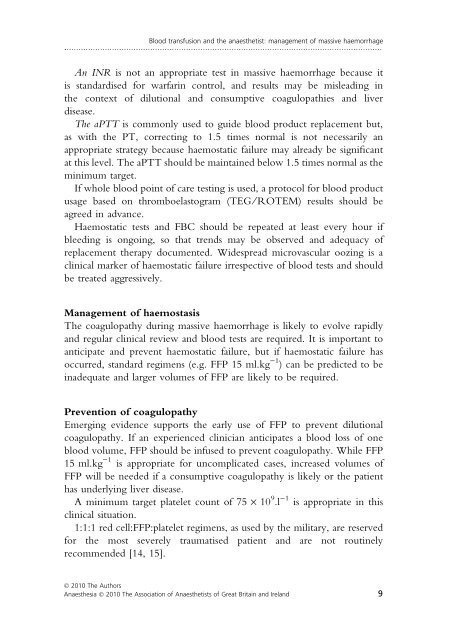Blood transfusion and the anaesthetist: management of ... - aagbi
Blood transfusion and the anaesthetist: management of ... - aagbi
Blood transfusion and the anaesthetist: management of ... - aagbi
Create successful ePaper yourself
Turn your PDF publications into a flip-book with our unique Google optimized e-Paper software.
<strong>Blood</strong> <strong>transfusion</strong> <strong>and</strong> <strong>the</strong> anaes<strong>the</strong>tist: <strong>management</strong> <strong>of</strong> massive haemorrhage<br />
.....................................................................................................................................<br />
An INR is not an appropriate test in massive haemorrhage because it<br />
is st<strong>and</strong>ardised for warfarin control, <strong>and</strong> results may be misleading in<br />
<strong>the</strong> context <strong>of</strong> dilutional <strong>and</strong> consumptive coagulopathies <strong>and</strong> liver<br />
disease.<br />
The aPTT is commonly used to guide blood product replacement but,<br />
as with <strong>the</strong> PT, correcting to 1.5 times normal is not necessarily an<br />
appropriate strategy because haemostatic failure may already be significant<br />
at this level. The aPTT should be maintained below 1.5 times normal as <strong>the</strong><br />
minimum target.<br />
If whole blood point <strong>of</strong> care testing is used, a protocol for blood product<br />
usage based on thromboelastogram (TEG ⁄ ROTEM) results should be<br />
agreed in advance.<br />
Haemostatic tests <strong>and</strong> FBC should be repeated at least every hour if<br />
bleeding is ongoing, so that trends may be observed <strong>and</strong> adequacy <strong>of</strong><br />
replacement <strong>the</strong>rapy documented. Widespread microvascular oozing is a<br />
clinical marker <strong>of</strong> haemostatic failure irrespective <strong>of</strong> blood tests <strong>and</strong> should<br />
be treated aggressively.<br />
Management <strong>of</strong> haemostasis<br />
The coagulopathy during massive haemorrhage is likely to evolve rapidly<br />
<strong>and</strong> regular clinical review <strong>and</strong> blood tests are required. It is important to<br />
anticipate <strong>and</strong> prevent haemostatic failure, but if haemostatic failure has<br />
occurred, st<strong>and</strong>ard regimens (e.g. FFP 15 ml.kg )1 ) can be predicted to be<br />
inadequate <strong>and</strong> larger volumes <strong>of</strong> FFP are likely to be required.<br />
Prevention <strong>of</strong> coagulopathy<br />
Emerging evidence supports <strong>the</strong> early use <strong>of</strong> FFP to prevent dilutional<br />
coagulopathy. If an experienced clinician anticipates a blood loss <strong>of</strong> one<br />
blood volume, FFP should be infused to prevent coagulopathy. While FFP<br />
15 ml.kg )1 is appropriate for uncomplicated cases, increased volumes <strong>of</strong><br />
FFP will be needed if a consumptive coagulopathy is likely or <strong>the</strong> patient<br />
has underlying liver disease.<br />
A minimum target platelet count <strong>of</strong> 75 · 10 9 .l )1 is appropriate in this<br />
clinical situation.<br />
1:1:1 red cell:FFP:platelet regimens, as used by <strong>the</strong> military, are reserved<br />
for <strong>the</strong> most severely traumatised patient <strong>and</strong> are not routinely<br />
recommended [14, 15].<br />
Ó 2010 The Authors<br />
Anaes<strong>the</strong>sia Ó 2010 The Association <strong>of</strong> Anaes<strong>the</strong>tists <strong>of</strong> Great Britain <strong>and</strong> Irel<strong>and</strong> 9

















